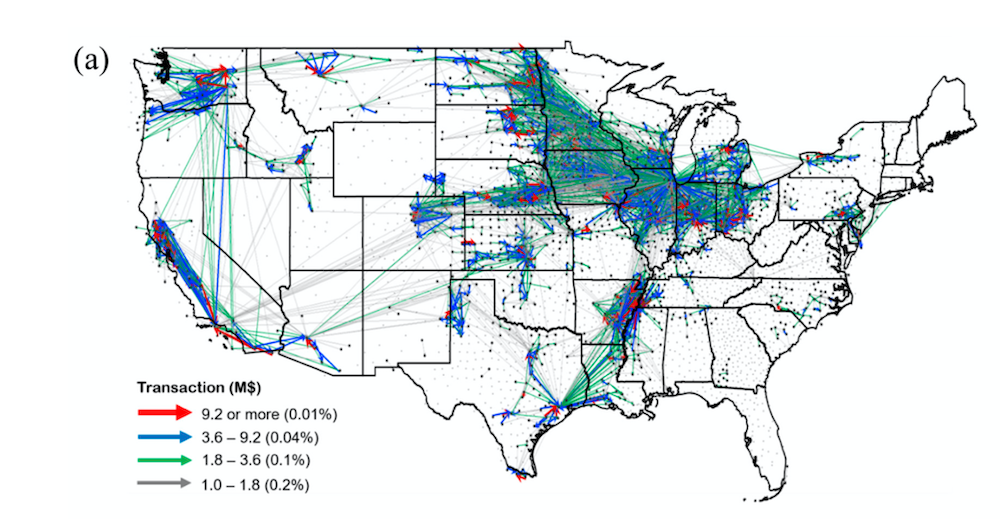
NERCRD researchers develop new tool for visualizing vulnerabilities in supply chains
February 11, 2021
“In any given industry, businesses rely on other industries to supply their inputs or to purchase their products for further processing, and the potential for bottlenecks or disruptions along these supply chains is real; we saw this play out on grocery store shelves across the nation last year,” said Stephan Goetz, professor of agricultural and regional economics and director of NERCRD. “Our study begins to demonstrate how we can geographically visualize these supply chains for any given sector using publicly available data, so that we may better prepare for future shocks.”
To construct their mathematical model, Goetz and his colleagues compiled county-level data from several publicly available sources, including data on employment by industry, farm sales, population, transportation, and transactions between and within industries. They used the U.S. national industry input-output table to measure all transactions between and among domestic industries.
In their study, published this month in the journal Sustainability, they applied their model for illustrative purposes to three industries representing different sectors of the economy — grain farming, motor vehicle manufacturing, and data processing — resulting in geographic visualizations of each of these industries’ supply chains.
For example, in their analysis of grain farming, they included not only the farms that produce corn, wheat and soybeans but also the businesses that provide those farms with inputs, such as fertilizer and equipment, as well as the processors who purchase grains to produce products ranging from livestock feed, high-fructose corn syrup and organic chemicals, to breads and pastries.
“Our visualizations confirm that grain farming is concentrated in the nation’s ‘breadbasket,’ which includes the Great Plains states of Illinois, Iowa, Kansas and the Dakotas,” Goetz said. “However, because our model considers upstream sellers of grain inputs and downstream grain buyers, it reveals that Arkansas, California and Washington also play important roles in the overall grain supply chain.”
These states would not appear as critical to the grain industry, if only grain production were considered, as is the case with rudimentary industry location maps, according to Goetz. By offering a higher-altitude view of the transactions between industries, the research offers potentially new insights into supply-chain vulnerabilities.
“In the case of a pandemic, public agencies and emergency responders could cross-reference these visualizations with data on infection hot-spots, for example, to better understand where protection of workers would be most critically needed in order to soften supply-chain disruptions,” he said. “Similarly, knowing where food processors are located relative to a tornado belt or wildfire zone could help them target resources aimed at mitigating disruptions.”
The team’s visualizations also show that most of the grain production activity, including activities related to inputs and processing, tends to be located primarily in rural areas, whereas most of the grain “consumption” activities, including milling, baking and retailing, are located in urban areas.
“This interdependence between rural and urban areas isn’t as pronounced in the two other industries we studied, but these illustrations raise an important policy point,” said Goetz. “To be a strong and sound partner of urban America, rural communities require public and private investments to build physical and human capacity, and investments in rural community development contribute to the well-being of urban areas, as well.”
Looking ahead, the researchers plan to build on this work by developing a platform that will allow local decision-makers to study their communities in much more detail, and that will allow users to focus on a particular commodity.
The research was funded by the USDA National Institute of Food and Agriculture, and was led by Yicheol Han, a research fellow at the Korea Rural Economic Institute in Nasu-si, South Korea, and formerly a research associate at NERCRD. Claudia Schmidt, assistant professor of agricultural economics in Penn State’s College of Agricultural Sciences, also contributed to this work.
